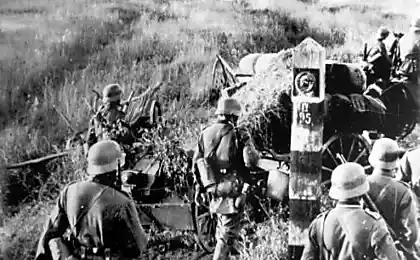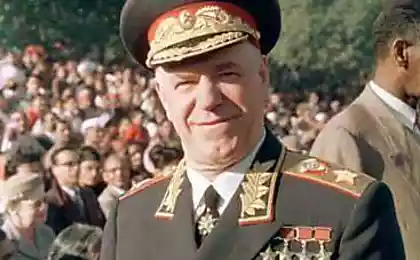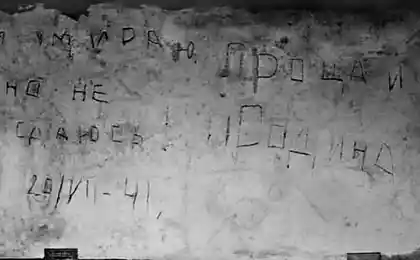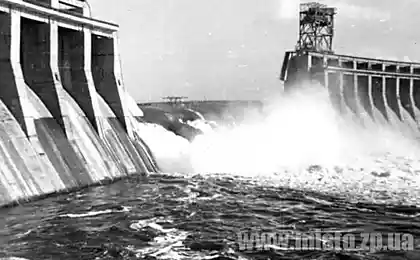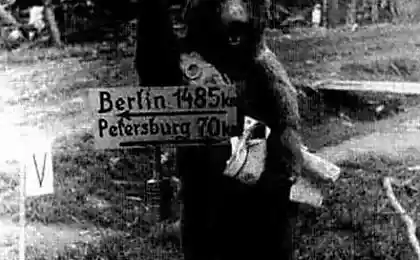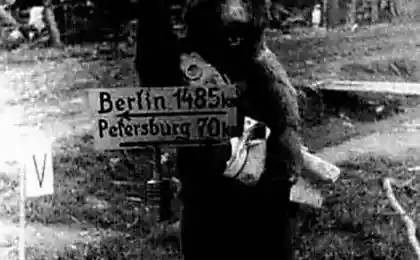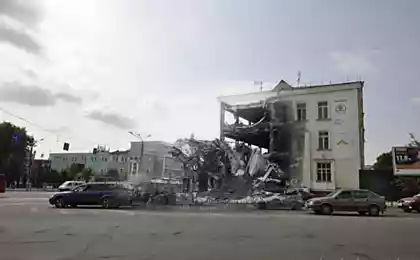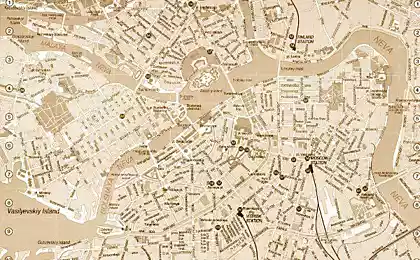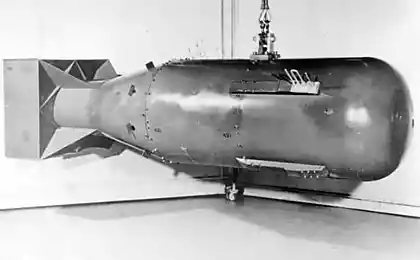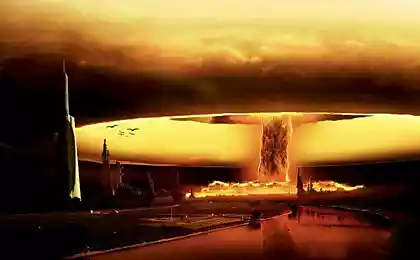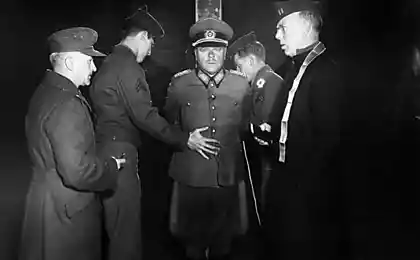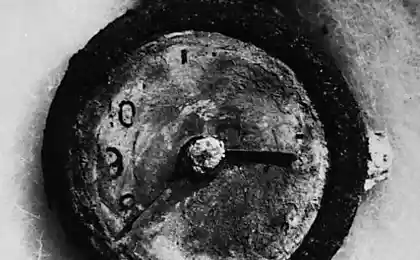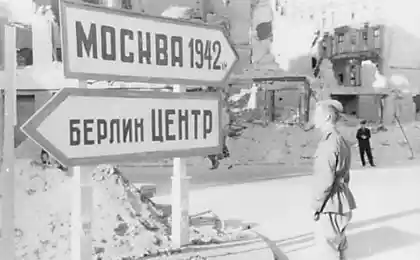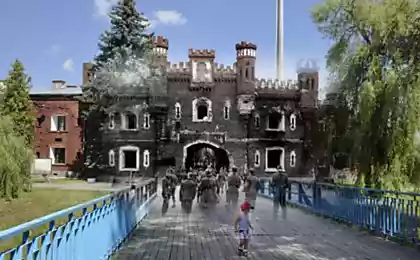1934
Map of the events of 1941-1945 in Leningrad
By the 66th anniversary of Victory in the Great Patriotic War, published map of the events of 1941-1945 in Leningrad, the most expressive talking about that time.
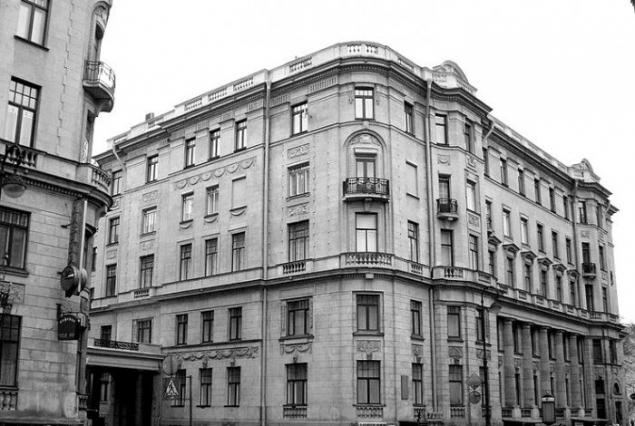
Stone Island Avenue, 26-28 (home Benoit). The birth of music time.
The famous Seventh Symphony of Shostakovich, later called "Leningrad", was composed in 1941-1942. The first three parts were written in the house on Kamennoostrovsky Benoit Avenue. Work on them Shostakovich completed in August 1941 and 8 September, began the siege of Leningrad.
"With pain and pride I looked at the beloved city. And he stood, singed by fires, battle-hardened, experienced profound suffering soldier, and was even more beautiful in its bleak greatness. It was not like this city, erected Peter, not to tell the whole world about its glory, about courage of its defenders ... My weapon was music, "- said Shostakovich later.
The finale of the symphony the composer is already finishing in Kuibyshev, where the Theatre of Opera and Ballet, and it was first performed on March 5, 1942. Blockade Leningrad heard cult product August 9, 1942. Along with medicines and other valuable cargo score brought the special plane from Kuibyshev broke the blockade ring.
He performed a symphony Symphony Orchestra of the Leningrad Radio Committee, in which, after the first severe winter blockade remains only 15 survivors weakened musicians. To fill the missing numbers orchestra musicians were sent to the front.
In spite of the bombing and air strikes in the Leningrad Philharmonic during a performance of the symphony were all lit chandeliers. All 80 minutes while the musicians played, the enemy guns were silent: the gunners defending the city were ordered: in whatever was to suppress the fire of the German guns.
During the execution of the symphony was broadcast on radio and over loudspeakers city network. She heard not only city residents but also besieged Leningrad by German troops. Much later, two tourists from the GDR, spotted conductor Karl Eliasberg, confessed to him: "Then, on August 9, 1942, we realized that we lost the war. We felt your strength, ability to overcome hunger, fear and even death ... »
"There were loudspeakers, the Germans heard it all. As it said, all Germans were mad when it heard. They somehow thought that the city of the dead "- says Galina Lelyukhin flutist.
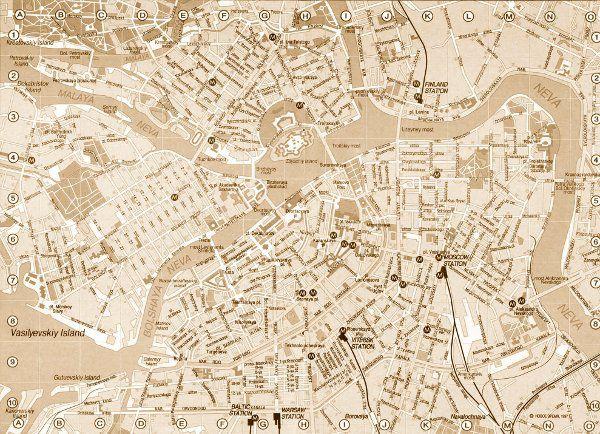
Italian street, 19. The only theater in the world, opened in the besieged city.
October 18, 1942 in besieged Leningrad - an unprecedented event in the history of the world! - Opened a new "city", the theater, the troupe of performers who have made the Radio and Drama Theatre. Pushkin. Later the company has replenished the actors of the New Youth Theatre and agitvzvoda Red Army House.
The theater opened play by K. Simonov, "Russian people". "Raise the curtain. On the stage - the Russian people. They - in the crowded auditorium - in coats, sailor's jackets in working overalls and quilted jackets. Leningradites perceive the play "Russian people" Simonov as a living profit, as a story about their own thoughts and feelings ", - the newspaper" Izvestia ».
The performances in the city theater began at 17 o'clock, the audience had time to get home before curfew. When the shelling started, everything down to the shelter and then returned to their seats, and the play continued. If the light is quenched, viewers sent their flashlights on the scene - and under this light was the performance.
During the siege there were performances of "Russian people" and "Wait for me," Konstantin Simonov, "Front" A. Korneichuk, "Invasion" Leonov, "The Marriage Belugina" Ostrovsky, "Oleko Dundich" Rzheshevsky and M . Katz.
In autumn 1944 the theater was renamed Leningrad dramatic, and since 1959 - a theater named Komissarzhevskaya Faith Fedorovna - in memory of the actress, who opened a theater in the same building on the Italian and led them in 1904-1906.
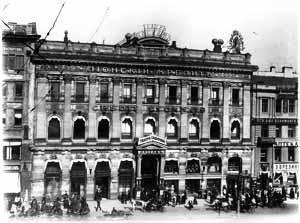
Dynamo Prospect, 44. "City of the Dead" plays football.
The stadium "Dynamo" in the last day of the spring of 1942 there was a match between teams "Dynamo" and "N-ray plant" (because at that time was "encrypted" Leningrad Metal Works). He lasted only half an hour, but by the fact the game has denied the contents of the German leaflets that were dropped from airplanes then: "Leningrad - the city of the dead. We do not take it yet because we are afraid of cadaveric epidemic. We wiped the city off the face of the earth ».
To carry out this match with best were recalled former players. The team "Dynamo" was composed almost entirely of players who spoke before the war, for the club, while the team was diverse LMZ. Many players union clubs have been evacuated from their industry. With great difficulty, I could play discharged from the hospital after a serious degeneration stage midfielder "Zenith" A. Misha. The first ball he received in a game on its head, knocked him down.
Footballers "Dinamo", thanks to the increased number of besieged soldering ("Dinamo" - a police team) were physically stronger and won the match with a score of 6: 0. But the victory was celebrated general - of death, grief, foe.
On the pediment of the entrance to the stadium "Dynamo" was a memorial plaque. It shows the silhouettes of football players and inscribed: "Here, at the stadium" Dynamo "in the most difficult days of the blockade 31 May 1942 Dynamo Leningrad siege held historic match with metal factory."

Hermitage. Evacuation eternal.
From the main museum of St. Petersburg during the war were evacuated 1,118,000 exhibits. They were sent to the Urals, Sverdlovsk, consisting of two levels. Work continued on the third-tier package, when closed the ring around Leningrad blockade. In Sverdlovsk, the first train arrived July 6, 1941, the second - on 30 July. During the evacuation has not gone none of the exhibit.
"June 22, 1941, all employees were called to the Hermitage Museum - recalled the director of the Hermitage in the Great Patriotic War, Joseph Orbeli. - Researcher of the Hermitage, its protection workers, technical employees - all were involved in the package, spending on food and rest less than an hour a day. And on the second day we came to the aid of hundreds of people who loved the Hermitage ... to food and rest of these people had to force an order. They Hermitage was more expensive than their strength and health & quot;
"All of us were in the barracks. The work was done around the clock ... boxes in which to pack they stood on the floor and had to work all the time vnaklonku. Soon many of us there was a nosebleed, "- says Alice Bank, a specialist in the field of art and the history of Byzantium and the Middle East.
For protection against air raids and shelling in the Hermitage were formed civil defense, and in the basement of the building equipped with reliable 12 shelters, which before 1942 had lived continuously for about two thousand people.
They say that even blockaded Hermitage conducted tour - not massive, of course. One of the staff drove people to the empty frames and window displays, telling about the exhibits that they have not been ...

Kirov area. The first trophies for Leningrad.
In August 1941, it is an exhibition of the first trophies from the front - German tanks, planes and other equipment. Thus, in Leningrad inspires optimism and belief in the imminent end of the war the victory of the Soviet Union.

The angle of Zagorodny Avenue and the streets of Borodino. Stilled the tram.
This is one of the places where the December 8, 1941, when Leningrad was left without electricity, just got the tram route. He stood there for more than a year.
In all 103 years - and so much time, there are trams in St. Petersburg - their movement is interrupted only once, in the siege of Leningrad. And during the war, trams were the main mode of transport in the city: all buses mobilized for the front and the trolley was still very small. In December 1941, tram in Leningrad because of interruptions in electricity supply was interrupted. But on March 8 went to the first freight train to clean the city from the snow and dirt to prevent epidemic diseases. And on April 15, 1942 to resume regular passenger tram.
After the break it was restored five tram routes. They say the Germans for a long time could not believe that the city trams. By all means, they tried to bomb the tram stops and parks. Profession motorman has become one of the most dangerous.
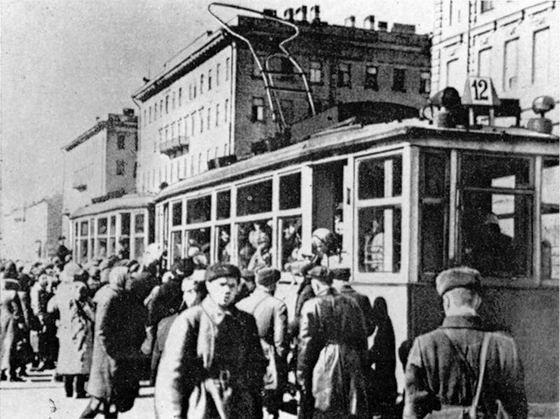
Vinokurtsevsky fare. One saved a little life.
A small passage near Vitebsk Station named after Paul D. Vinokurtsa, 13 district police stations in the Leninsky district. He died saving the girl during the shelling on Nov. 8, 1941.
How many people died in the besieged city, one never really tell. In the documents of the Soviet side at the Nuremberg Trials featured the figure of 650,000 dead, based on data on the number of buried. In some recent studies, this figure increased almost twice.
We know only one thing - when was completely lift the blockade in Leningrad, there are only 560,000 inhabitants, but during the evacuation of the road to the rear of starvation and disease killed every fourth.
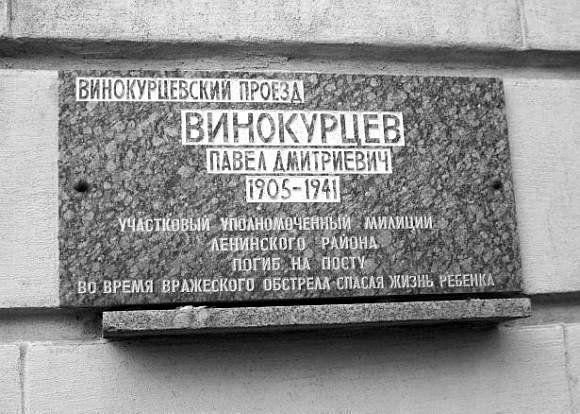
Nevsky Prospect, 39. Save and Preserve.
In the yards Anichkov Palace figures were buried with their horses Klodt Anichkov Bridge. So many of St. Petersburg monuments saved from attacks.
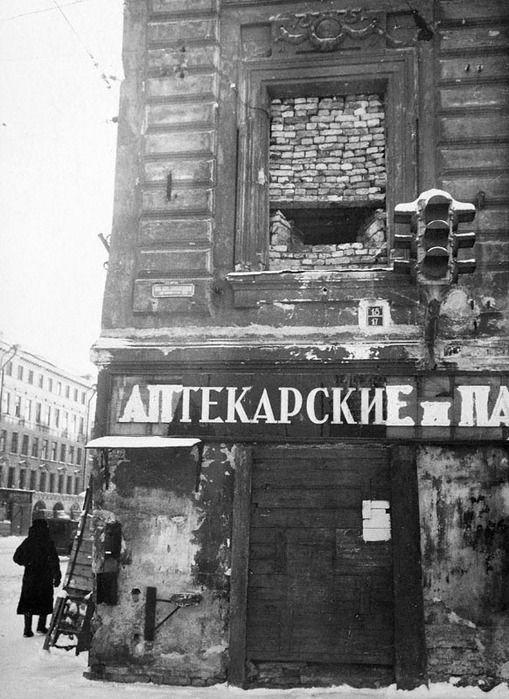
On a granite pedestal instead of sculptures were exhibited boxes sown with grass. Equestrian statues were returned to the place on the eve of May 1, 1945.
During the siege of Leningrad bridge itself significantly affected by the artillery attack. Damage received granite parapets and railing sections. The crossing has become a monument to the blockade: on the granite pedestal horses Klodt specifically did not restore the track from the German artillery shell fragments.

Suvorov Square. Indestructible monument to courage.
During the war, Suvorov monument, as well as monuments to Kutuzov and Barclay de Tolly, was not camouflaged. People believed that, while intact statues of great generals, the enemy will not happen in the city. The troops went to the front, saluted the monument to Suvorov.
There is a legend according to which a monument to Generalissimo still like to hide in the basement of a house located not far from Suvorov Square. However, the night one of those responsible for the transfer of the monument, appeared in a dream he Suvorov: he shakes his finger and reminded that during his lifetime has never been a coward and would not want them to be after death. He angrily told what cowards die in the war first. The order to move the monument was lifted, and several days later the enemy projectile flying past a bronze monument to the head, hit right in the very basement, which would hide the monument.
Total war monument Suvorov was hurt.
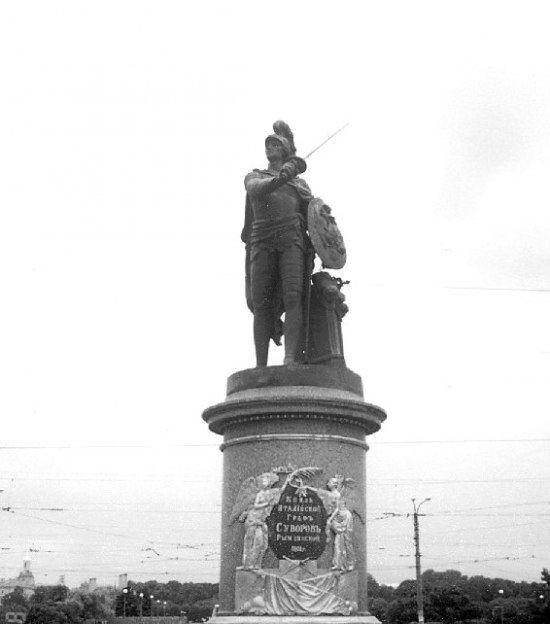
Professor Popov Street, 10. Art does not burn.
Matyushina House, now the Museum of St. Petersburg avant-garde - virtually the only wooden building, which during the siege of Leningrad was not dismantled for firewood.
The house was built in 1840-1850-ies in the garden, passed in the second half of the nineteenth century in the possession of the "Society benefit needy writers and scholars." In 1912, in the apartment number 12, one of the pioneers settled Russian avant-garde - the artist, the author of the theory of 'expanded looking', musician, teacher, publisher Mikhail Matyushin with his wife Elena Guro Genrichovna.
For several decades Matyushina house was one of the centers of cultural life of St. Petersburg-Petrograd-Leningrad, brings together artists, musicians, writers. In 1910-1920-ies are often visited Malevich, torsion, Mayakovsky, Khlebnikov and other artists. During the Great Patriotic War in the house often gathered writers Fadeev, Tikhonov, Inber, Dudin, Crone. The apartment Matyushina widow Olga Konstantinovna from August 1942 to November 1944 living writer Vsevolod Vishnevsky.
During the siege of almost all wooden houses in the city were demolished for firewood. The same fate is likely, and waited for the house Matyushina. However, at the initiative of Vishnevsky writers appealed to the Leningrad City Committee with a request to keep the house. The request was granted.
In April 2004, it was decided to open a museum in the house Matyushina Petersburg avant-garde.
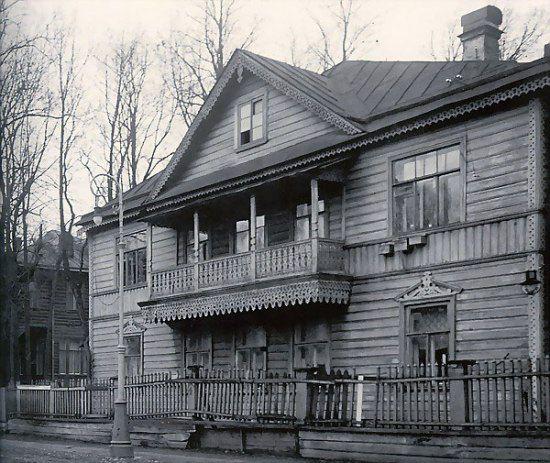
Corner of Nevsky Prospekt and Malaya Morskaya streets. "The General's" store.
During the siege there was a shop, which is popularly known as "The General's." It was a closed valve, which merchandised spetskartochki senior officers and the general's composition. Ordinary people were not allowed - the number and range of products offered in the shop they could only guess.
Meanwhile, the rate of release of the goods on the ration cards, introduced in the city in July, 41-year, due to the blockade declined and reached a minimum in the period from 20 November to 25 December 1941.
The size of the food ration was:
• Workers - 250 grams of bread a day,
• employees, dependents and children up to 12 years - 125 grams,
• Personnel of paramilitary security, fire brigade, fighter units, vocational schools and schools FZO, located on the boiler allowance - 300 grams,
• first-line troops - 500 grams.
At the same time 50% of bread were almost inedible impurities are added instead of flour. All other products have almost ceased to be issued: even September 23, 1941 to cease production of beer, and all stocks of malt, barley, soybeans and bran were transferred to bakeries, to reduce the amount of flour. On September 24 the bread was 40% of the malt, and oat hulls, and later - even from the pulp (at different time from 20 to 50%)

Corner of Pestel and moss. "Hanging over the abyss wall mirror ...»
During the shelling, one wall of the house at the corner of Pestel and Moss collapsed, but at the level of 6 floors left hanging surviving mirror. It impressed the poet Vadim Shefner, who wrote the poem "Mirror":
How terrible blow to the ramming
Here, half of the house demolished,
And clouds frosty mist
Charred wall stands.
Another wallpaper torn remember
About former life, peaceful and simple,
But the doors of all the rooms collapsed,
Disclosed, hanging over the void.
And let me forget everything else - I do not forget how, in the wind shaking,
Hanging over the abyss wall mirror
At the height of the sixth floor.
It somehow miraculously did not break.
Killed people, swept away by the wall, -
It hangs the fate of the blind mercy,
Catcher grief and war.
Witness prewar comfort,
On the damp wall pitted
Warm breath and smile someone
It keeps the glass depth.
Where is she, unknown, gone
Or wandering along the roads of how,
That girl that looked deep into his
And braids braided in front of him? ..
Perhaps this view mirrors
Her last moment, when her
Chaos fragments of stone and metal,
Collapsed down, he threw into oblivion.
Now in it day and night looking
Face fierce war.
It gunfire lightning
And the glow visible alarm.
It is now strangling the damp night,
Blindly fire with smoke and fire,
But it will pass. And no matter what happens, -
The enemy is never reflected in it!
Later, when the war ended, the architects rebuilt the house, and at the level of 6 floors make a small indentation, which now is only around the oval window of the house - in the form of a mirror.

English Angle Avenue and the Decembrists street. Destroyed tale.
In 1909, the architect commissioned Bernardazzi gold-Koltsov built on the corner of the street Officers (now Decembrists street) and English Avenue apartment house, immediately after his appearance at St. Petersburg received the nickname of "House-tale".
Bizarre mix of different romantic styles - features "Northern Art Nouveau" and "national identity", windows and balconies of intricate shapes, corner tower, facing the walls of natural stone and colorful majolica panels helped to create in the background Townhouse old Kolomna magical spectacle reminiscent of a dazzling theatrical scenery. On the facade of a sculptor Konstantin Rausch Traubenberg carved stone bird Phoenix, which if supported on their wings corner bay window "House-tale".
The proximity of the Mariinsky Theatre to a large extent determine the composition of the first tenants of the house. It was mostly theater actors and workers. There was rehearsing the great Russian ballerina Anna Pavlova, and therefore among Petersburgers this house was known as "The House Anna Pavlova".
In 1942, the "fairy tale" was completely destroyed. Since the foundation of the house only survived, it was decided to build a new building on it.
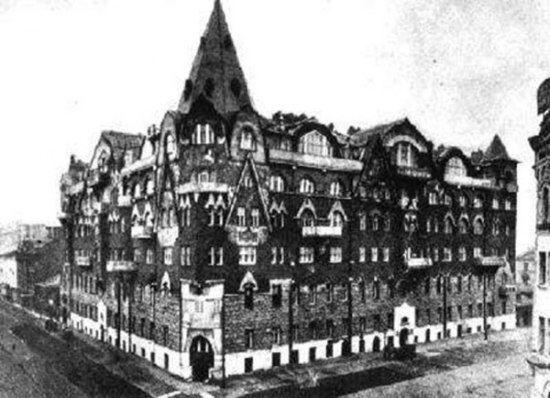
Fontanka Embankment, 21. The cold source of life.
Few people know that St. Petersburg has a monument to Leningrad hole. It was installed in 2001 on the approaches to the water in the house №21 on the Fontanka embankment.

Stone Island Avenue, 26-28 (home Benoit). The birth of music time.
The famous Seventh Symphony of Shostakovich, later called "Leningrad", was composed in 1941-1942. The first three parts were written in the house on Kamennoostrovsky Benoit Avenue. Work on them Shostakovich completed in August 1941 and 8 September, began the siege of Leningrad.
"With pain and pride I looked at the beloved city. And he stood, singed by fires, battle-hardened, experienced profound suffering soldier, and was even more beautiful in its bleak greatness. It was not like this city, erected Peter, not to tell the whole world about its glory, about courage of its defenders ... My weapon was music, "- said Shostakovich later.
The finale of the symphony the composer is already finishing in Kuibyshev, where the Theatre of Opera and Ballet, and it was first performed on March 5, 1942. Blockade Leningrad heard cult product August 9, 1942. Along with medicines and other valuable cargo score brought the special plane from Kuibyshev broke the blockade ring.
He performed a symphony Symphony Orchestra of the Leningrad Radio Committee, in which, after the first severe winter blockade remains only 15 survivors weakened musicians. To fill the missing numbers orchestra musicians were sent to the front.
In spite of the bombing and air strikes in the Leningrad Philharmonic during a performance of the symphony were all lit chandeliers. All 80 minutes while the musicians played, the enemy guns were silent: the gunners defending the city were ordered: in whatever was to suppress the fire of the German guns.
During the execution of the symphony was broadcast on radio and over loudspeakers city network. She heard not only city residents but also besieged Leningrad by German troops. Much later, two tourists from the GDR, spotted conductor Karl Eliasberg, confessed to him: "Then, on August 9, 1942, we realized that we lost the war. We felt your strength, ability to overcome hunger, fear and even death ... »
"There were loudspeakers, the Germans heard it all. As it said, all Germans were mad when it heard. They somehow thought that the city of the dead "- says Galina Lelyukhin flutist.

Italian street, 19. The only theater in the world, opened in the besieged city.
October 18, 1942 in besieged Leningrad - an unprecedented event in the history of the world! - Opened a new "city", the theater, the troupe of performers who have made the Radio and Drama Theatre. Pushkin. Later the company has replenished the actors of the New Youth Theatre and agitvzvoda Red Army House.
The theater opened play by K. Simonov, "Russian people". "Raise the curtain. On the stage - the Russian people. They - in the crowded auditorium - in coats, sailor's jackets in working overalls and quilted jackets. Leningradites perceive the play "Russian people" Simonov as a living profit, as a story about their own thoughts and feelings ", - the newspaper" Izvestia ».
The performances in the city theater began at 17 o'clock, the audience had time to get home before curfew. When the shelling started, everything down to the shelter and then returned to their seats, and the play continued. If the light is quenched, viewers sent their flashlights on the scene - and under this light was the performance.
During the siege there were performances of "Russian people" and "Wait for me," Konstantin Simonov, "Front" A. Korneichuk, "Invasion" Leonov, "The Marriage Belugina" Ostrovsky, "Oleko Dundich" Rzheshevsky and M . Katz.
In autumn 1944 the theater was renamed Leningrad dramatic, and since 1959 - a theater named Komissarzhevskaya Faith Fedorovna - in memory of the actress, who opened a theater in the same building on the Italian and led them in 1904-1906.

Dynamo Prospect, 44. "City of the Dead" plays football.
The stadium "Dynamo" in the last day of the spring of 1942 there was a match between teams "Dynamo" and "N-ray plant" (because at that time was "encrypted" Leningrad Metal Works). He lasted only half an hour, but by the fact the game has denied the contents of the German leaflets that were dropped from airplanes then: "Leningrad - the city of the dead. We do not take it yet because we are afraid of cadaveric epidemic. We wiped the city off the face of the earth ».
To carry out this match with best were recalled former players. The team "Dynamo" was composed almost entirely of players who spoke before the war, for the club, while the team was diverse LMZ. Many players union clubs have been evacuated from their industry. With great difficulty, I could play discharged from the hospital after a serious degeneration stage midfielder "Zenith" A. Misha. The first ball he received in a game on its head, knocked him down.
Footballers "Dinamo", thanks to the increased number of besieged soldering ("Dinamo" - a police team) were physically stronger and won the match with a score of 6: 0. But the victory was celebrated general - of death, grief, foe.
On the pediment of the entrance to the stadium "Dynamo" was a memorial plaque. It shows the silhouettes of football players and inscribed: "Here, at the stadium" Dynamo "in the most difficult days of the blockade 31 May 1942 Dynamo Leningrad siege held historic match with metal factory."

Hermitage. Evacuation eternal.
From the main museum of St. Petersburg during the war were evacuated 1,118,000 exhibits. They were sent to the Urals, Sverdlovsk, consisting of two levels. Work continued on the third-tier package, when closed the ring around Leningrad blockade. In Sverdlovsk, the first train arrived July 6, 1941, the second - on 30 July. During the evacuation has not gone none of the exhibit.
"June 22, 1941, all employees were called to the Hermitage Museum - recalled the director of the Hermitage in the Great Patriotic War, Joseph Orbeli. - Researcher of the Hermitage, its protection workers, technical employees - all were involved in the package, spending on food and rest less than an hour a day. And on the second day we came to the aid of hundreds of people who loved the Hermitage ... to food and rest of these people had to force an order. They Hermitage was more expensive than their strength and health & quot;
"All of us were in the barracks. The work was done around the clock ... boxes in which to pack they stood on the floor and had to work all the time vnaklonku. Soon many of us there was a nosebleed, "- says Alice Bank, a specialist in the field of art and the history of Byzantium and the Middle East.
For protection against air raids and shelling in the Hermitage were formed civil defense, and in the basement of the building equipped with reliable 12 shelters, which before 1942 had lived continuously for about two thousand people.
They say that even blockaded Hermitage conducted tour - not massive, of course. One of the staff drove people to the empty frames and window displays, telling about the exhibits that they have not been ...

Kirov area. The first trophies for Leningrad.
In August 1941, it is an exhibition of the first trophies from the front - German tanks, planes and other equipment. Thus, in Leningrad inspires optimism and belief in the imminent end of the war the victory of the Soviet Union.

The angle of Zagorodny Avenue and the streets of Borodino. Stilled the tram.
This is one of the places where the December 8, 1941, when Leningrad was left without electricity, just got the tram route. He stood there for more than a year.
In all 103 years - and so much time, there are trams in St. Petersburg - their movement is interrupted only once, in the siege of Leningrad. And during the war, trams were the main mode of transport in the city: all buses mobilized for the front and the trolley was still very small. In December 1941, tram in Leningrad because of interruptions in electricity supply was interrupted. But on March 8 went to the first freight train to clean the city from the snow and dirt to prevent epidemic diseases. And on April 15, 1942 to resume regular passenger tram.
After the break it was restored five tram routes. They say the Germans for a long time could not believe that the city trams. By all means, they tried to bomb the tram stops and parks. Profession motorman has become one of the most dangerous.

Vinokurtsevsky fare. One saved a little life.
A small passage near Vitebsk Station named after Paul D. Vinokurtsa, 13 district police stations in the Leninsky district. He died saving the girl during the shelling on Nov. 8, 1941.
How many people died in the besieged city, one never really tell. In the documents of the Soviet side at the Nuremberg Trials featured the figure of 650,000 dead, based on data on the number of buried. In some recent studies, this figure increased almost twice.
We know only one thing - when was completely lift the blockade in Leningrad, there are only 560,000 inhabitants, but during the evacuation of the road to the rear of starvation and disease killed every fourth.

Nevsky Prospect, 39. Save and Preserve.
In the yards Anichkov Palace figures were buried with their horses Klodt Anichkov Bridge. So many of St. Petersburg monuments saved from attacks.

On a granite pedestal instead of sculptures were exhibited boxes sown with grass. Equestrian statues were returned to the place on the eve of May 1, 1945.
During the siege of Leningrad bridge itself significantly affected by the artillery attack. Damage received granite parapets and railing sections. The crossing has become a monument to the blockade: on the granite pedestal horses Klodt specifically did not restore the track from the German artillery shell fragments.

Suvorov Square. Indestructible monument to courage.
During the war, Suvorov monument, as well as monuments to Kutuzov and Barclay de Tolly, was not camouflaged. People believed that, while intact statues of great generals, the enemy will not happen in the city. The troops went to the front, saluted the monument to Suvorov.
There is a legend according to which a monument to Generalissimo still like to hide in the basement of a house located not far from Suvorov Square. However, the night one of those responsible for the transfer of the monument, appeared in a dream he Suvorov: he shakes his finger and reminded that during his lifetime has never been a coward and would not want them to be after death. He angrily told what cowards die in the war first. The order to move the monument was lifted, and several days later the enemy projectile flying past a bronze monument to the head, hit right in the very basement, which would hide the monument.
Total war monument Suvorov was hurt.

Professor Popov Street, 10. Art does not burn.
Matyushina House, now the Museum of St. Petersburg avant-garde - virtually the only wooden building, which during the siege of Leningrad was not dismantled for firewood.
The house was built in 1840-1850-ies in the garden, passed in the second half of the nineteenth century in the possession of the "Society benefit needy writers and scholars." In 1912, in the apartment number 12, one of the pioneers settled Russian avant-garde - the artist, the author of the theory of 'expanded looking', musician, teacher, publisher Mikhail Matyushin with his wife Elena Guro Genrichovna.
For several decades Matyushina house was one of the centers of cultural life of St. Petersburg-Petrograd-Leningrad, brings together artists, musicians, writers. In 1910-1920-ies are often visited Malevich, torsion, Mayakovsky, Khlebnikov and other artists. During the Great Patriotic War in the house often gathered writers Fadeev, Tikhonov, Inber, Dudin, Crone. The apartment Matyushina widow Olga Konstantinovna from August 1942 to November 1944 living writer Vsevolod Vishnevsky.
During the siege of almost all wooden houses in the city were demolished for firewood. The same fate is likely, and waited for the house Matyushina. However, at the initiative of Vishnevsky writers appealed to the Leningrad City Committee with a request to keep the house. The request was granted.
In April 2004, it was decided to open a museum in the house Matyushina Petersburg avant-garde.

Corner of Nevsky Prospekt and Malaya Morskaya streets. "The General's" store.
During the siege there was a shop, which is popularly known as "The General's." It was a closed valve, which merchandised spetskartochki senior officers and the general's composition. Ordinary people were not allowed - the number and range of products offered in the shop they could only guess.
Meanwhile, the rate of release of the goods on the ration cards, introduced in the city in July, 41-year, due to the blockade declined and reached a minimum in the period from 20 November to 25 December 1941.
The size of the food ration was:
• Workers - 250 grams of bread a day,
• employees, dependents and children up to 12 years - 125 grams,
• Personnel of paramilitary security, fire brigade, fighter units, vocational schools and schools FZO, located on the boiler allowance - 300 grams,
• first-line troops - 500 grams.
At the same time 50% of bread were almost inedible impurities are added instead of flour. All other products have almost ceased to be issued: even September 23, 1941 to cease production of beer, and all stocks of malt, barley, soybeans and bran were transferred to bakeries, to reduce the amount of flour. On September 24 the bread was 40% of the malt, and oat hulls, and later - even from the pulp (at different time from 20 to 50%)

Corner of Pestel and moss. "Hanging over the abyss wall mirror ...»
During the shelling, one wall of the house at the corner of Pestel and Moss collapsed, but at the level of 6 floors left hanging surviving mirror. It impressed the poet Vadim Shefner, who wrote the poem "Mirror":
How terrible blow to the ramming
Here, half of the house demolished,
And clouds frosty mist
Charred wall stands.
Another wallpaper torn remember
About former life, peaceful and simple,
But the doors of all the rooms collapsed,
Disclosed, hanging over the void.
And let me forget everything else - I do not forget how, in the wind shaking,
Hanging over the abyss wall mirror
At the height of the sixth floor.
It somehow miraculously did not break.
Killed people, swept away by the wall, -
It hangs the fate of the blind mercy,
Catcher grief and war.
Witness prewar comfort,
On the damp wall pitted
Warm breath and smile someone
It keeps the glass depth.
Where is she, unknown, gone
Or wandering along the roads of how,
That girl that looked deep into his
And braids braided in front of him? ..
Perhaps this view mirrors
Her last moment, when her
Chaos fragments of stone and metal,
Collapsed down, he threw into oblivion.
Now in it day and night looking
Face fierce war.
It gunfire lightning
And the glow visible alarm.
It is now strangling the damp night,
Blindly fire with smoke and fire,
But it will pass. And no matter what happens, -
The enemy is never reflected in it!
Later, when the war ended, the architects rebuilt the house, and at the level of 6 floors make a small indentation, which now is only around the oval window of the house - in the form of a mirror.

English Angle Avenue and the Decembrists street. Destroyed tale.
In 1909, the architect commissioned Bernardazzi gold-Koltsov built on the corner of the street Officers (now Decembrists street) and English Avenue apartment house, immediately after his appearance at St. Petersburg received the nickname of "House-tale".
Bizarre mix of different romantic styles - features "Northern Art Nouveau" and "national identity", windows and balconies of intricate shapes, corner tower, facing the walls of natural stone and colorful majolica panels helped to create in the background Townhouse old Kolomna magical spectacle reminiscent of a dazzling theatrical scenery. On the facade of a sculptor Konstantin Rausch Traubenberg carved stone bird Phoenix, which if supported on their wings corner bay window "House-tale".
The proximity of the Mariinsky Theatre to a large extent determine the composition of the first tenants of the house. It was mostly theater actors and workers. There was rehearsing the great Russian ballerina Anna Pavlova, and therefore among Petersburgers this house was known as "The House Anna Pavlova".
In 1942, the "fairy tale" was completely destroyed. Since the foundation of the house only survived, it was decided to build a new building on it.

Fontanka Embankment, 21. The cold source of life.
Few people know that St. Petersburg has a monument to Leningrad hole. It was installed in 2001 on the approaches to the water in the house №21 on the Fontanka embankment.
